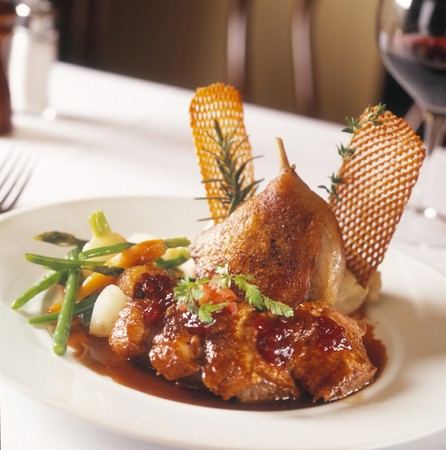Hungry Hieroglyphics Part 1

Are you ever confused from looking at a menu at a swanky restaurant because you’re not familiar with the descriptive words? I’ve worked in the industry for quite some time and I’m still coming across verbiage that is totally unfamiliar to me. So here’s a breakdown of some of the words you’d find in the Scripps National Spelling Bee carte de jour, some you might be familiar with, most of them, you’re probably not–no offense. I’ll have a second part once I delve into my encyclopedia of edible things and come up with some more unfamiliar terms.
Aioli: You see this with burgers and fries now days and all it consists of is egg yolks and oil, simply put, mayonnaise.
Confit: Most of the time it’s seen next to duck, but you see this next to fruit, chicken, goose, pork, etc. All this means is that the ingredient was cooked in fat of some kind and preserved. It can also mean to cook in sugar for fruits.
Julienne/Batonnet: These are all various kinds of cuts of an ingredient. Batonnet is French for small stick, and is similar in size to julienne. Thin slices of vegetables around the size of 1/8 in. to ¼ in. would be considered within that range.
Béchamel: It’s a white sauce made with milk and thickened with a light roux(even parts butter and flour, traditionally 70 grams butter/70 grams flour for one liter of milk) and flavored with a white roux (onions, celery)
Beurre blanc: A fish dish is something this would go well with. It means “white butter” in French and is an emulsified sauce made with a reduction of white wine, shallots, thickened with whole butter and finished with herbs or seasonings.
Amuse bouche: French for appetizer, this chef’s tasting of something unique, exotic or special comes out when seated at a restaurant.
Bouillabaisse: A French fish stew that’s flavored with tomatoes, onions, garlic, white wine and saffron.
Brunoise: When you see something diced very, very small, around 1/16 in., that’s usually considered a brunoise cut.
Charcuterie: The preparation of pork and other meat items. Sausages, terrines, pates and other forcemeats are examples.
Chiffonade: Leafy vegetables or herbs that are cut into fine ribbons and usually used as a garnish.
Concasse: If you think of salsa, this is the French word for taking a tomato, peeling it, seeding and chopping it into small pieces.
Crème anglaise: Ice cream is usually made from this French custard made with crème or milk, sugar eggs and vanilla. This can be served as a sauce garnish or as stated above, turned into ice cream.
Sometimes you find fancy words for simple things on the menu, and now you’ll know what some of them mean. I might not have covered everything in this glossary of terms, but this should help you to read a menu a little better and decipher its hieroglyphics making you hungry.
Copyright TableAgent.com
© Restaurant Agent Inc.